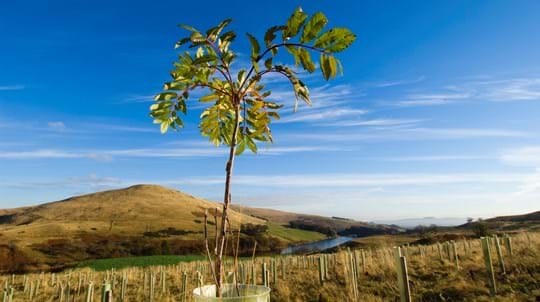
Credit: Blickwinkel / Alamy Stock Photo
Leaves
Dark green and lobed, with an undulate margin.
Less famous than English oak, but no less loved, the sessile oak towers in the woods. Squirrels, jays and badgers love their acorns and caterpillars flock to eat their leaves, in fact 326 species of wildlife are found only on oak.
Common name: sessile oak
Scientific name: Quercus petraea
Family: Fagaceae
Origin: native
Sessile oak is a deciduous broadleaf tree which can grow 20–40m tall.
Look out for: leaves which are lobed with a long leaf stalk. The leaf lobes are shallow.
Identified in winter by: rounded buds which are in clusters. Each bud has more than three scales.

Credit: Blickwinkel / Alamy Stock Photo
Dark green and lobed, with an undulate margin.

Credit: FloralImages / Alamy Stock Photo
Sessile oak is monoecious, meaning male and female flowers are found on the same tree. Male flowers are green catkins and female flowers are inconspicuous clusters of bracts (modified leaves), which resemble red flower buds.

Credit: Leaves galore / Den Reader / Alamy Stock Photo
After pollination by wind, female flowers develop into a large shiny seed held in a scaly wooden cup, commonly known as an acorn. Young acorns are green, maturing to brown before they fall. Sessile, which means stalkless, refers to the acorns which are directly attached to the twigs at their base.
English, or pedunculate, oak (Quercus robur). Sessile oak has stalkless (sessile) acorns and the two species often hybridise. It has a more upright trunk and straighter branches than English oak, and the leaves have longer stalks.

Have you noticed buds bursting into leaf or fruit ripening in the hedgerows? Tell us what's happening to the trees around you and help scientists track the effects of climate change on wildlife.
Take part in our Nature's Calendar surveyIt is the official national tree of Ireland and is native to most of Europe, commonly located in hilly regions.
Over its lifespan, an oak tree can produce as many as five million acorns.
Whether sessile or pedunculate, oak trees support more wildlife than any other native trees. They provide a habitat for more than 257 species of insect, which are the food source for birds and other predators. The bark also provides a habitat for mosses, lichens and liverworts, and deadwood cavities for nesting birds and roosting bats. The acorns are eaten by a number of birds and mammals, including the jay, badger and red squirrel.
Flower and leaf buds of English and sessile oak are the food plants of the caterpillars of purple hairstreak butterflies.
The soft leaves break down with ease in autumn and form a rich leaf mould beneath the tree, supporting beetles and numerous fungi, such as the oakbug milkcap.

Our fantastic oaks support more life than any other UK native tree. Discover which species live and feed on oak, from foxes and fungi to bats and beetles.
Explore oak wildlifeThe oak was sacred to many gods including Zeus, Jupiter and the Celtic Dagda. Each of these gods ruled over thunder and lightning, and oak trees are often hit by lightning as they are the tallest living feature in the landscape.
Druids practised rituals in oak groves and cherished the mistletoe that grows in oak tree branches. It’s also linked with royalty: ancient kings and Roman Emperors wore crowns of oak leaves.
In England, the oak is a national symbol of strength. Couples were wed under ancient oaks in Oliver Cromwell’s time. Oak is the emblem of many environmental groups, including the Woodland Trust.
Every five to 10 years, depending on conditions, there’s a bumper crop in what is referred to as a mast year, when the tree produces up to 10,000 acorns in one season.
Oaks produce one of the hardest and most durable timbers on the planet. However, it takes up to 150 years before an oak is ready to use in construction. It has been a prized hardwood timber for thousands of years and is still used for flooring, wine barrels and firewood.
Other uses of oak:
Acute oak decline and chronic oak decline are serious conditions affecting Britain’s oaks, with several contributing factors linked to the diseases. Decline of mature oaks first caused concern in the 1920s and today, most cases are in central, southern and eastern England.
The oak processionary moth is a non-native pest that has been found in London, Surrey and Berkshire. Not only does it damage the foliage of the trees and increase the oak’s susceptibility to other diseases, it is actually a risk to human health. The moth’s hairs are toxic and can lead to itching and respiration problems.

Trees woods and wildlife
Use our free Tree ID app for Android and iPhone to identify the UK's native and non-native trees.

Shop
We have single trees and tree packs to meet your needs, from wildlife to woodfuel. Delivery is free.
External link
Journal
PDF (4.47 MB)